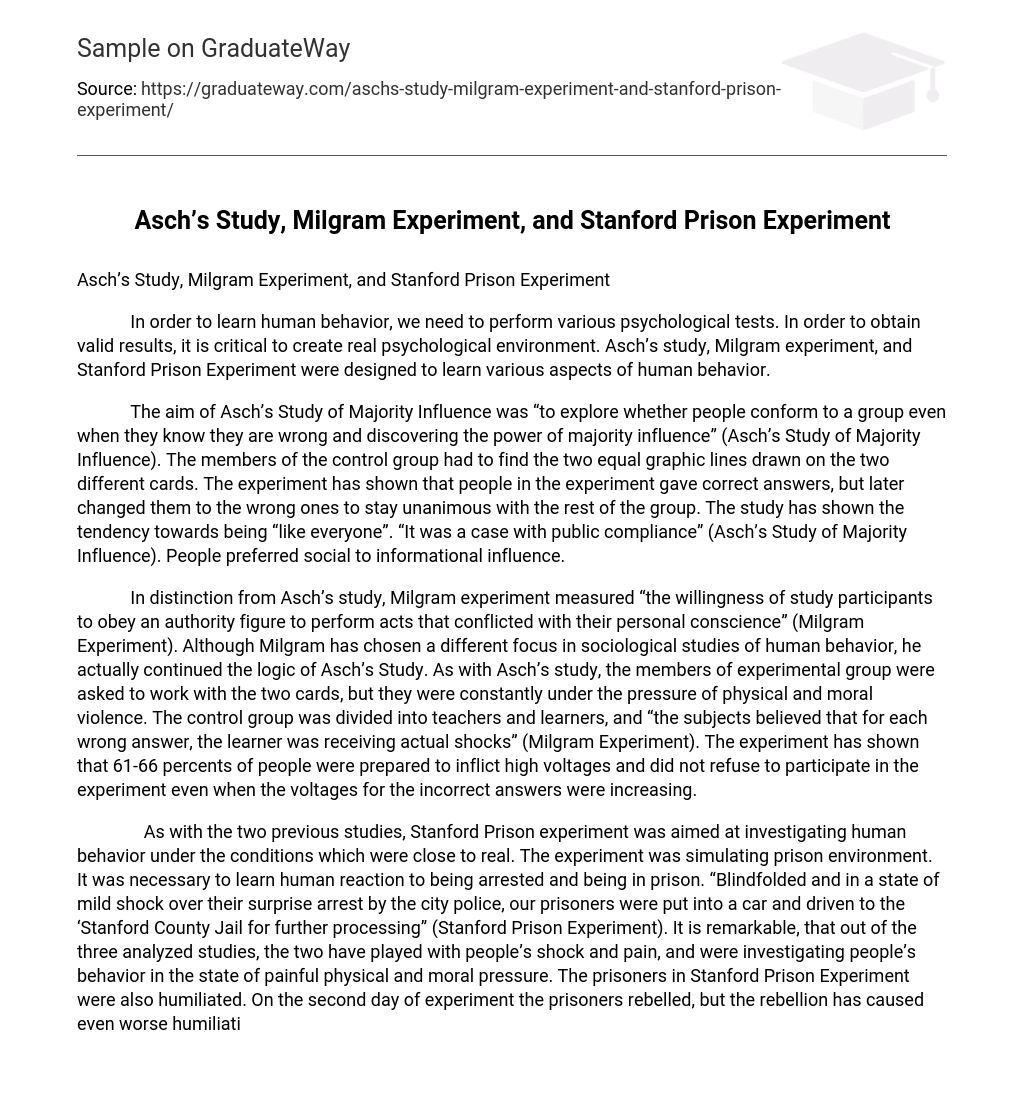In order to learn human behavior, we need to perform various psychological tests. In order to obtain valid results, it is critical to create real psychological environment. Asch’s study, Milgram experiment, and Stanford Prison Experiment were designed to learn various aspects of human behavior.
The aim of Asch’s Study of Majority Influence was “to explore whether people conform to a group even when they know they are wrong and discovering the power of majority influence” (Asch’s Study of Majority Influence). The members of the control group had to find the two equal graphic lines drawn on the two different cards. The experiment has shown that people in the experiment gave correct answers, but later changed them to the wrong ones to stay unanimous with the rest of the group. The study has shown the tendency towards being “like everyone”. “It was a case with public compliance” (Asch’s Study of Majority Influence). People preferred social to informational influence.
In distinction from Asch’s study, Milgram experiment measured “the willingness of study participants to obey an authority figure to perform acts that conflicted with their personal conscience” (Milgram Experiment). Although Milgram has chosen a different focus in sociological studies of human behavior, he actually continued the logic of Asch’s Study. As with Asch’s study, the members of experimental group were asked to work with the two cards, but they were constantly under the pressure of physical and moral violence. The control group was divided into teachers and learners, and “the subjects believed that for each wrong answer, the learner was receiving actual shocks” (Milgram Experiment). The experiment has shown that 61-66 percents of people were prepared to inflict high voltages and did not refuse to participate in the experiment even when the voltages for the incorrect answers were increasing.
As with the two previous studies, Stanford Prison experiment was aimed at investigating human behavior under the conditions which were close to real. The experiment was simulating prison environment. It was necessary to learn human reaction to being arrested and being in prison. “Blindfolded and in a state of mild shock over their surprise arrest by the city police, our prisoners were put into a car and driven to the ‘Stanford County Jail for further processing” (Stanford Prison Experiment). It is remarkable, that out of the three analyzed studies, the two have played with people’s shock and pain, and were investigating people’s behavior in the state of painful physical and moral pressure. The prisoners in Stanford Prison Experiment were also humiliated. On the second day of experiment the prisoners rebelled, but the rebellion has caused even worse humiliation of prisoners and has produced better solidarity among guards. The prison environment was too real, and many subjects broke into hysteria and crying. Five days were enough to understand that it was time to end the experiment. All three studies had to research the will of a person under a pressure of certain environmental conditions or social opinions of others. The three described experiments have not only shown the weaknesses of personal will, but also the ability of many people to survive conditions close to real.
Works Cited
“Asch’s Study of Majority Influence”. 2007. Psychology Key Studies Website. 02 March
2008. http://www2.qeliz.ac.uk/psychology/Asch.htm
“Milgram Experiment”. 2008. Reference. 02 March 2008.
http://www.reference.com/browse/wiki/Milgram_experiment
“Stanford Prison Experiment”. 2008. Stanford Prison Experiment. 02 March 2008.
http://www.prisonexp.org/





